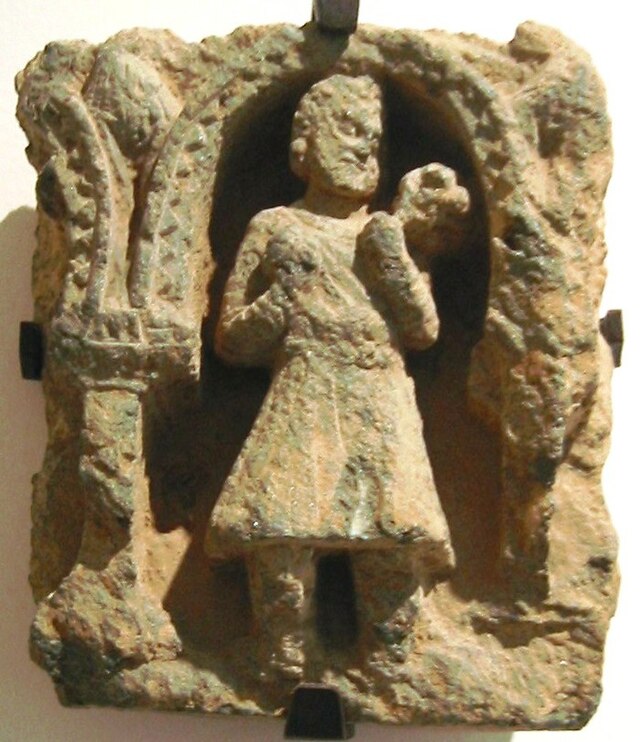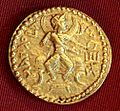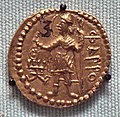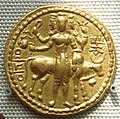贵霜帝国(古希腊语:Βασιλεία Κοσσανῶν;巴克特里亚语:Kushano;梵语:कुषाण वंश;婆罗米文:![]()
![]()
![]() ,Ku-ṣā-ṇa;佛教混合梵文:Guṣāṇa-vaṃśa;安息语:𐭊𐭅𐭔𐭍 𐭇𐭔𐭕𐭓,Kušan-xšaθr:Κυϸανο;英语:Kushan Empire) 是曾存在于中亚、南亚的古代国家(约公元1世纪至3世纪),在其鼎盛时期(105年—250年)疆域从今日的塔吉克斯坦绵延至里海、阿富汗及恒河流域。贵霜帝国在迦腻色伽一世和其承继者统治之下达至鼎盛,曾拥有人口千万,被认为是当时亚欧四大强国之一,与汉、罗马、安息三个同一时期的帝国并列。
,Ku-ṣā-ṇa;佛教混合梵文:Guṣāṇa-vaṃśa;安息语:𐭊𐭅𐭔𐭍 𐭇𐭔𐭕𐭓,Kušan-xšaθr:Κυϸανο;英语:Kushan Empire) 是曾存在于中亚、南亚的古代国家(约公元1世纪至3世纪),在其鼎盛时期(105年—250年)疆域从今日的塔吉克斯坦绵延至里海、阿富汗及恒河流域。贵霜帝国在迦腻色伽一世和其承继者统治之下达至鼎盛,曾拥有人口千万,被认为是当时亚欧四大强国之一,与汉、罗马、安息三个同一时期的帝国并列。
此条目需要补充更多来源。 (2018年8月27日) |
建立

前130年,月氏人南下征服大夏,把大夏分给五个部族,每个部族有一个酋长,称为翕侯[1],前一世纪初,大月氏五翕侯中的贵霜翕侯丘就却(约16—65年)消灭其他翕侯,统一五部落,建立起贵霜国,丘就却打败了开始衰落的安息,又南下攻击喀布尔河流域和今喀什米尔地区,后定都为高附(今喀布尔),初步奠定了帝国的基础[2]。
强盛
丘就却死后,其子阎膏珍(65—75年)继位,又南下进兵印度,占领了恒河上游地区,任命一个将军进行统治,帝国仍定都中亚,当中《汉书》说是监氏城[3],《后汉书》说是蓝氏城[4],具体地点不详,有说即是大夏首都巴克特拉。阎膏珍还铸造金币,从货币上的人像看,他是信奉印度的湿婆神。
之后,迦腻色伽一世(约78—102年)继位,他是贵霜帝国最著名的君主,根据罗巴塔克铭文记载,他是阎膏珍之子。迦腻色伽一世时,又南征印度,占领了娑枳多(Sāketa)、桥赏弥(Kauśāmbī)和华氏城(Pataliputra)并远至室利瞻波(Śrī-Campā)。令贵霜帝国的疆域西起伊朗边境,东至恒河中游,北起锡尔河、葱岭、南至纳巴达河,迦腻色伽一世又将都城迁至犍陀罗地区的富楼沙(即今巴基斯坦的白沙瓦),使这一地区成为帝国的统治中心。在100年时贵霜帝国的统治下的人口达到1020万人,在180年时贵霜帝国统治下的人口达到1380万人。
迦腻色伽一世曾与东汉发生过一次战争,据《后汉书 班梁列传》所载,汉和帝永元二年(90年),贵霜副王谢率兵七万人攻班超,汉军人少,坚守不战,谢攻班超不下,四处搜掠又无所得,粮草出现问题。班超推断谢会向龟兹求援,就派兵埋伏要道,谢果然不出所料,结果求援士兵全被杀掉,班超将消息告知谢,谢自知已无出路,便派使者向班超请罪,要求放还,班超同意,两国关系又重修好,自此贵霜军退回葱岭以南,两国保持和平关系。[5]
经济和文化
贵霜帝国地处中亚丝绸之路的交通要道,是中国丝绸、漆器、东南亚香料、罗马玻璃制品、麻织品等贸易中转站。从其铸造的金币可以知道其与罗马帝国的商业关系。另外,这些金币所表达的各种希腊宙斯和胜利女神奈基、罗马、祆教祭坛、耆那教的公牛、印度教和佛教神祇可以证明贵霜对发扬于当地的宗教和艺术的宽容和融合的关系。凭借贵霜在中亚丝绸之路上的活跃,他们也为发源自古代伊朗的摩尼教和基督教聂斯脱里派教会东传中国开通道路[6]。语言文字方面,早期使用希腊文字和语言,后来创制自己的婆罗米文与吐火罗语。一些学者认为,贵霜皇朝是希腊后裔建立的帝国。

贵霜帝国前三位国王,丘就却信佛教,阎膏珍信婆罗门教,迦腻色伽一世又信佛教,其中以迦腻色伽一世对佛教的支持和宣扬最大。由于迦腻色伽一世是透过暴力使帝国达到极盛期,为了巩固统治,需要缓和社会上的种种矛盾,因此强调种姓的婆罗门教就不如不承认种姓差别的佛教有效,又因为迦腻色伽一世不是印度贵族出身,在婆罗门教的种姓制度下不能占有适当的位置,因此迦腻色伽一世就选取以佛教管治帝国。迦腻色伽一世下令修建富楼沙的大讲经堂,还雕刻了一批佛像,又把一批出色的佛教学者招到自己身边,包括胁尊者,世友,众护,马鸣等。迦腻色伽一世又在胁尊者的提议下召开了一次佛教结集大会,因为当时佛教内部已有许多不同学派,对教义解释不尽相同,这次会议由世友主持,经过讨论,对经、律、论三藏都重新作出了解释。贵霜帝国一时成为了佛教中心,由于贵霜帝国扼丝绸之路的要冲,与东方汉代中国有密切商业来往,佛教也由此传入中国。
贵霜帝国时期也是佛教开始发生重大变化的时间,由于皇家鼓励书面写作和文字文学,大量之前一直以口诵传承的经典开始书面化。社会文化素养的提高客观上为大乘佛教的传播打下基础。此时大乘佛教兴起成为佛教主流。然迦腻色伽一世对佛教采取各派兼容的政策,其中世友尊者就是说一切有部的佛教学者,马鸣菩萨则是大乘佛教学者,佛教从贵霜帝国传入中国时也是说一切有部和大乘佛教一同传入。不过,总而言之,以后大乘佛教主要从北方传入中国,再进而传到朝鲜和日本,而上座部佛教则向南传入斯里兰卡,再而进入东南亚诸国。
衰亡


贵霜帝国内有着许多社会结构不同的地区,包括商业发达的城市,也有农业及游牧的地区,贵霜帝国面对不同地区,只得采取不同统治方法,对中亚的一些小邦,如花剌子模,只要其纳贡称臣,就允许其保持半独立的状态,对于印度河、恒河流域各邦,征服后往往杀其君长,再命副王统治,可见贵霜帝国本身不是一个高度集中统一的政治实体,要靠经常的反复征服来维持。迦腻色伽一世晚年时欲北进,然而国内人民已对战争政策无法容忍,相传当他卧病在床时,人们用被闷死了他。迦腻色伽一世死后,贵霜帝国实力大减,在2世纪时,帝国仍勉强维持统一,3世纪时,受到萨珊王朝攻击和印度北部的地方势力兴起而渐渐衰弱,最终帝国瓦解成若干小邦。现在印度贾特人是他们后人。
历代君主
由于过去历史学家不能解读佉卢文,而各国的史料的内容又有矛盾,所以,过去一直都未能就贵霜王朝的各个君主整理出一个有系统的列表出来。
- 赫拉欧斯(1年—30年)
- 丘就却(30年—80年),首位贵霜皇帝 / (45年~77年)
- 阎膏珍(80年—105年)“无名王”索特尔·麦格斯(意为“伟大的救世主”)
- 阎珍(105年—127年)
- 迦腻色伽一世(127年—147年)
- 婆湿色伽(151年—155年)
- 胡毗色伽(155年—187年)
- 韦苏提婆一世(191年—最少至230年),贵霜王朝最后一个君主
- 迦腻色迦二世(226年—240年)
- 婆什色迦Vashishka(240年—250年)
- 迦腻色伽三世(255年—275年)
- 韦苏提婆二世(290年—310年)
- Chhu(310年?—325年?)
- Shaka I(325年—345年)
- Kipunada(350年—375年)
在贵霜帝国货币上出现的神
-
胡弗色迦硬币上的摩诃斯那王
-
Oisho
-
Rishti.
-
智慧之神——玛诺巴格 (Manaobago)
-
发罗 (Pharro)
-
丰收女神阿尔多克修 (Ardochsho)
-
Oisho
-
Oisho
-
斯卡塔尔和卫塞(Visakha)
-
迦腻色伽一世的金币,有希腊风格。
参考文献
- Avari, Burjor. India: The Ancient Past. London: Routledge. 2007. ISBN 978-0-415-35616-9.
- Beckwith, Christopher I. Empires of the Silk Road: A History of Central Eurasia from the Bronze Age to the Present. Princeton University Press. 2009. ISBN 978-1-4008-2994-1.
- Benjamin, Craig. The Yuezhi: Origin, Migration and the Conquest of Northern Bactria. ISD. 2007. ISBN 978-2-503-52429-0.
- Bopearachchi, Osmund. De l'Indus à l'Oxus, Archéologie de l'Asie Centrale. Lattes: Association imago-musée de Lattes. 2003. ISBN 2-9516679-2-2 (法语).
- Bopearachchi, Osmund. Some Observations on the Chronology of the Early Kushans. Gyselen, Rika (编). Des Indo-Grecs aux Sassanides: données pour l'histoire et la géographie historique XVII. Group pour l'Etude de la Civilisation du Moyen-Orient. 2007.
- Chavannes, Édouard. Trois Généraux Chinois de la dynastie des Han Orientaux. Pan Tch'ao (32–102 p.C.); – son fils Pan Yong; – Leang K'in (112 p.C.). Chapitre LXXVII du Heou Han chou.. T'oung pao 7. 1906.
- Chavannes, Édouard. Les pays d'occident d'après le Heou Han chou. T'oung pao 8. 1907: 149–244.
- Dani, Ahmad Hasan; Litvinsky, Boris Abramovich; Zamir Safi, M. H. "Eastern Kushans, Kidarines in Gandhara ans Kashmir, and Later Hephthalites". In Litvinsky (1996).
- Dorn'eich, Chris M. (2008). Chinese sources on the History of the Niusi-Wusi-Asi (oi)-Rishi (ka)-Arsi-Arshi-Ruzhi and their Kueishuang-Kushan Dynasty. Shiji 110/Hanshu 94A: The Xiongnu: Synopsis of Chinese original Text and several Western Translations with Extant Annotations. Berlin. To read or download go to: [1] (页面存档备份,存于互联网档案馆)
- Enoki, K.; Koshelenko, G. A.; Haidary, Z. "The Yu'eh-chih and their migrations". In Harmatta, Puri & Etemadi (1994).
- Faccenna, Domenico (1980). Butkara I (Swāt, Pakistan) 1956–1962, Volume III 1 (in English). Rome: IsMEO (Istituto Italiano Per Il Medio Ed Estremo Oriente).
- Falk, Harry. Silk Road Art and Archaeology IV. 1995–1996.
- Falk, Harry. The yuga of Sphujiddhvaja and the era of the Kuṣāṇas. Silk Road Art and Archaeology VII. 2001: 121–136.
- Falk, Harry. The Kaniṣka era in Gupta records. Silk Road Art and Archaeology X. 2004: 167–176.
- Foucher, M. A. 1901. "Notes sur la geographie ancienne du Gandhâra (commentaire à un chaptaire de Hiuen-Tsang)." BEFEO No. 4, Oct. 1901, pp. 322–369.
- Golden, Peter B. An Introduction to the History of the Turkic Peoples. Harrassowitz Verlag. 1992.
- Goyal, S. R. Ancient Indian Inscriptions. Jodhpur, India: Kusumanjali Book World. 2005.
- Grousset, René. The Empire of the Steppes: A History of Central Asia
 . Rutgers University Press. 1970. ISBN 978-0-8135-1304-1.
. Rutgers University Press. 1970. ISBN 978-0-8135-1304-1. - Hargreaves, H. (1910–11). "Excavations at Shāh-jī-kī Dhērī"; Archaeological Survey of India. pp. 25–32.
- Harmatta, János. "Religions in the Kushan Empire". In Harmatta, Puri & Etemadi (1999).
- Harmatta, János; Puri, B. N.; Etemadi, G. F. (编). History of Civilizations of Central Asia. Volume II The Development of Sedentary and Nomadic Civilizations, 700 B.C. to A.D. 250. Paris: UNESCO. 1994 [29 May 2015]. ISBN 978-92-3-102846-5. (原始内容存档于2022-06-08).
- Harmatta, János; Puri, B. N.; Etemadi, G. F. (编). History of Civilizations of Central Asia. Volume II The Development of Sedentary and Nomadic Civilizations, 700 B.C. to A.D. 250. Delhi: Motilal Banarsidass. 1999 [1994] [31 July 2021]. ISBN 978-8-1208-1408-0. (原始内容存档于2020-01-22).
- Hill, John E. 2004. The Peoples of the West from the Weilüe 魏略 by Yu Huan 鱼豢: A Third Century Chinese Account Composed between 239 and 265 CE. Draft annotated English translation. [2] (页面存档备份,存于互联网档案馆)
- Hill, John E. Through the Jade Gate to Rome: A Study of the Silk Routes during the Later Han Dynasty, First to Second Centuries CE. BookSurge. 2009. ISBN 978-1-4392-2134-1.
- Hoey, W. "The Word Kozola as Used of Kadphises on Ku͟s͟hān Coins." Journal of the Royal Asiatic Society of Great Britain and Ireland, 1902, pp. 428–429. .
- Iloliev, A. "King of Men: ῾Ali ibn Abi Talib in Pamiri Folktales." Journal of Shi'a Islamic Studies, vol. 8 no. 3, 2015, pp. 307–323. Project MUSE, doi:10.1353/isl.2015.0036.
- Kennedy, J. "The Later Kushans." Journal of the Royal Asiatic Society of Great Britain and Ireland, 1913, pp. 1054–1064. .
- Konow, Sten, ed. 1929. Kharoshthī Inscriptions with Exception of those of Asoka. Corpus Inscriptionum Indicarum, Vol. II, Part I. Reprint: Indological Book House, Varanasi, 1969.
- Lebedynsky, Iaroslav. Les Saces. Paris: Editions Errance. 2006. ISBN 2-87772-337-2.
- Lerner, Martin. The flame and the lotus: Indian and Southeast Asian art from the Kronos collections. New York: The Metropolitan Museum of Art. 1984 [2021-08-16]. ISBN 0-87099-374-7. (原始内容存档于2017-08-26).
- Litvinsky, Boris Abramovich (编). History of Civilizations of Central Asia. Volume III The crossroads of civilizations: A.D. 250 to 750. Paris: UNESCO. 1996 [2021-08-16]. ISBN 9789231032110. (原始内容存档于2022-05-20).
- Liu, Xinru. Migration and Settlement of the Yuezhi-Kushan: Interaction and Interdependence of Nomadic and Sedentary Societies. Journal of World History (University of Hawaii Press). Fall 2001, 12 (2): 261–292 [2021-08-16]. doi:10.1353/jwh.2001.0034. (原始内容存档于2021-04-18).
- Liu, Xinru. The Silk Road in World History. New York: Oxford University Press. 2010.
- Loewe, Michael; Shaughnessy, Edward L. The Cambridge History of Ancient China: From the Origins of Civilization to 221 BC. Cambridge University Press. 1999. ISBN 0-521-47030-7. doi:10.1017/CHOL9780521470308.
- Mallory, J. P. Encyclopedia of Indo-European Culture. Taylor & Francis. 1997. ISBN 1-884964-98-2.
- Mallory, J. P.; Mair, Victor H. The Tarim Mummies: Ancient China and the Mystery of the Earliest Peoples from the West. Thames & Hudson. 2008. ISBN 978-0-500-28372-1.
- Masson, V. M. "The Forgotten Kushan Empire: New Discoveries at Zar-Tepe." Archaeology, vol. 37, no. 1, 1984, pp. 32–37. .
- Narain, A. K. Indo-Europeans in Central Asia. Sinor, Denis (编). The Cambridge History of Early Inner Asia 1. Cambridge University Press. 1990: 151–177. ISBN 978-1-139-05489-8. doi:10.1017/CHOL9780521243049.007.
- Pulleyblank, Edwin G. Chinese and Indo-Europeans. The Journal of the Royal Asiatic Society of Great Britain and Ireland. 1966, 98 (1/2): 9–39. JSTOR 25202896. doi:10.1017/S0035869X00124566.
- Puri, Baij Nath. "The Sakas and Indo-Parthians". In Harmatta, Puri & Etemadi (1994).
- Puri, Baij Nath. "The Kushans". In Harmatta, Puri & Etemadi (1999).
- "Red Sandstone Railing Pillar." The British Museum Quarterly, vol. 30, no. 1/2, 1965, pp. 64–64. .
- Rezakhani, Khodadad. East Iran in Late Antiquity. ReOrienting the Sasanians: East Iran in Late Antiquity. Edinburgh University Press. 2017a: 1–256. ISBN 978-1-4744-0030-5. JSTOR 10.3366/j.ctt1g04zr8.

- Rezakhani, Khodadad. From the Kushans to the Western Turks. Daryaee, Touraj (编). King of the Seven Climes: A History of the Ancient Iranian World (3000 BCE - 651 CE). UCI Jordan Center for Persian Studies. 2017b: 1–236. ISBN 978-0-692-86440-1.
- Rife, J. L. "The Making of Roman India by Grant Parker (review)." American Journal of Philology, vol. 135 no. 4, 2014, pp. 672–675. Project MUSE, doi:10.1353/ajp.2014.0046.
- Rosenfield, John M. The Dynastic Arts of the Kushans. University of California Press. 1967 [2021-08-16]. (原始内容存档于2022-04-24).
- Rosenfield, John M. The Dynastic Art of the Kushans. New Delhi: Munshiram Manoharlal. 1993. ISBN 81-215-0579-8.
- Roux, Jean-Paul. L'Asie Centrale, Histoire et Civilization [Central Asia: History and Civilization]. Fayard. 1997. ISBN 978-2-213-59894-9 (法语).
- Sailendra Nath Sen. Ancient Indian History and Civilization. New Age International. 1999 [2021-08-16]. ISBN 978-81-224-1198-0. (原始内容存档于2019-11-19).
- Sarianidi, Viktor. 1985. The Golden Hoard of Bactria: From the Tillya-tepe Excavations in Northern Afghanistan. Harry N. Abrams, Inc. New York.
- Sims-Williams, Nicholas; Cribb, Joe. "A new Bactrian inscription of Kanishka the Great". In Falk (1995–1996), pp. 75–142.
- Sims-Williams, Nicholas. 1998. "Further notes on the Bactrian inscription of Rabatak, with an Appendix on the names of Kujula Kadphises and Vima Taktu in Chinese." Proceedings of the Third European Conference of Iranian Studies Part 1: Old and Middle Iranian Studies. Edited by Nicholas Sims-Williams. Wiesbaden. pp. 79–93.
- Sivaramamurti, C. Śatarudrīya: Vibhūti of Śiva's Iconography. Delhi: Abhinav Publications. 1976.
- Spooner, D. B. (1908–09). "Excavations at Shāh-jī-kī Dhērī."; Archaeological Survey of India. pp. 38–59.
- Watson, Burton. Trans. 1993. Records of the Grand Historian of China: Han Dynasty II. Translated from the Shiji of Sima Qian. Chapter 123: "The Account of Dayuan", Columbia University Press. Revised Edition. ISBN 0-231-08166-9; ISBN 0-231-08167-7 (pbk.)
- Wink, André. Al-Hind: The Slavic Kings and the Islamic conquest, 11th-13th centuries. BRILL. 2002.
- Zürcher, E. The Yüeh-chih and Kaniṣka in the Chinese sources. Basham, A. L. (编). Papers on the Date of Kaniṣka. Leiden: E. J. Brill. 1968: 346–393.
注释与引用
Wikiwand in your browser!
Seamless Wikipedia browsing. On steroids.
Every time you click a link to Wikipedia, Wiktionary or Wikiquote in your browser's search results, it will show the modern Wikiwand interface.
Wikiwand extension is a five stars, simple, with minimum permission required to keep your browsing private, safe and transparent.













